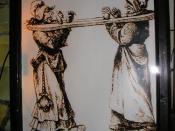During the horrifying days of the abuse scandal in Iraq, many people had different opinions about what happened, how it happened, why it happened, and who was responsible. From the first moments the pictures came out, all different media quickly looked over the facts and were struck with horror. CNN said of the abuse it is "one of universal disgust" and CBC describes the pictures as "graphic revelations". All the media that I researched told the same fundamental facts, but each's view of the Americans was different.
Time magazine interviewed Haider Sabbar Abed al-Abbadi, who was one of the seven prisoners from Abu Ghraib who were photographed by the Americans. The article "The Scandal's Growing Stain" from Time magazine is an example of a news report about the victims, and is of the prisoner's point of view. Al- Abbadi told Times magazine how he was treated, such as having a bag put over his head, being stripped him naked, and photographed; and other forms of torture he experienced.
The reader can feel the horror and emotion from al- Abbadi's facts. Articles such as this contain many important facts but are biased because the person telling the story will always say he is right.
Soon after the news broke out, many American soldiers were put on trial. Jeremy Sivits and Sabrina Harman were the first ones to be trialed. Most of the articles concerning these incidences are simply facts and what the charges were. There were not much biased views based on the trials. Many articles criticized George W. Bush and Donald Rumsfled, but many lack facts with evidence that they were to blame. Some mock Bush saying his "dream team" failed. Rumsfled's blame rarely had a direct connection with what happened in Iraq.
One of the articles I found was...



I agree
i agree with your opinion, and this essay is very well written, i think you did a great job, in my opinion i dislike Bush and what he did to those ppl. he had no right, and he still did not find those "wepons" he was talking about. ne ways great job!
5 out of 5 people found this comment useful.